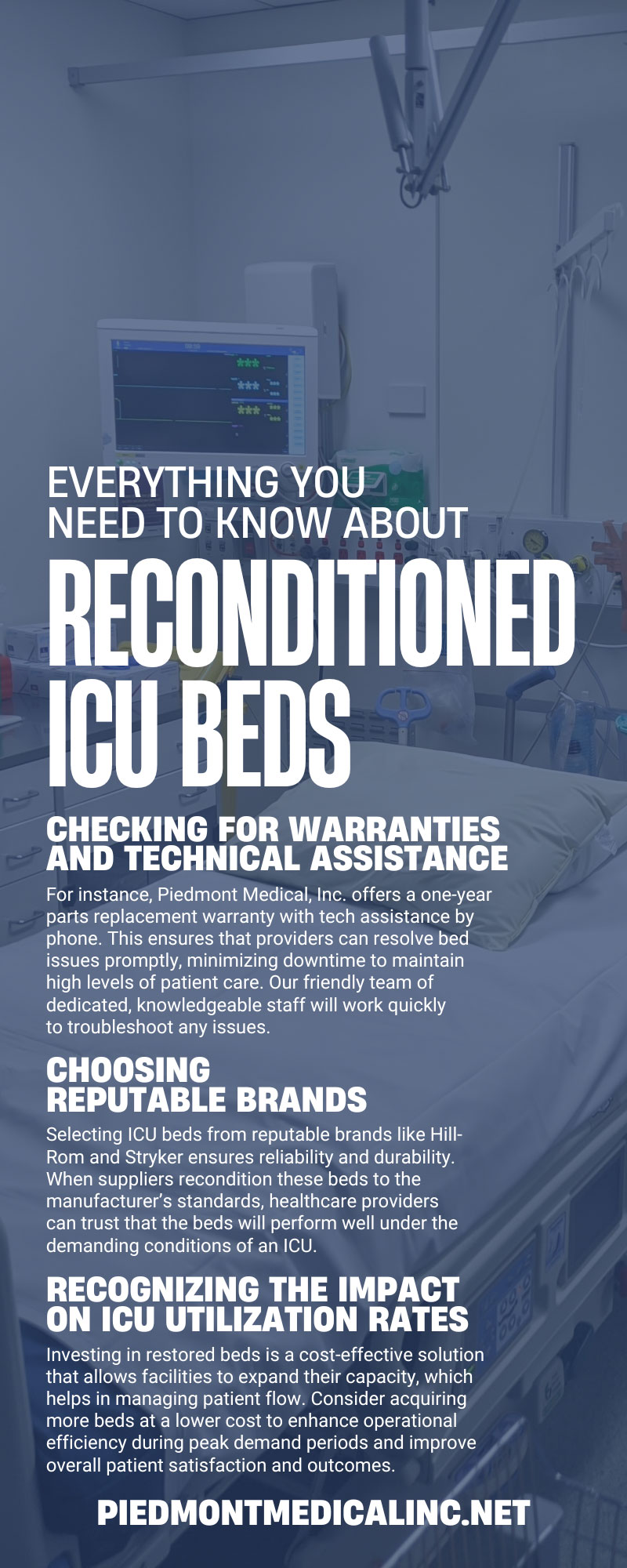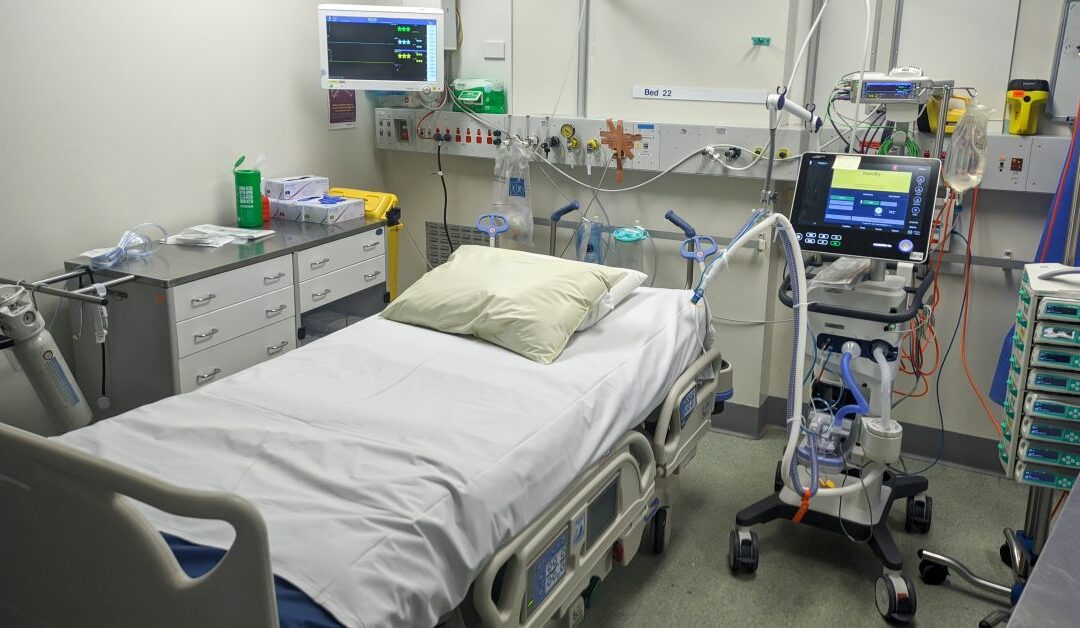When it comes to critical care, every piece of medical equipment provides essential healthcare support. For instance, reconditioned ICU beds offer advanced technology, durability, and cost-efficiency. With features like multi-positional adjustments, vital sign monitoring integrations, and ease of sanitation, reconditioned ICU beds help protect patient health. Learn everything you need to know about reconditioned ICU beds to find the right equipment for your facility.
Supporting Patient Recovery
Reconditioned ICU beds offer the necessary adjustments and support that critically ill patients need for optimal recovery. By providing comfort and functionality, these beds help healthcare providers deliver high-quality care.
Consider the ways in which quality hospital beds support patient recovery:
- Enhanced monitoring capabilities: Reconditioned ICU beds often come equipped with advanced monitoring systems that allow healthcare professionals to track vital signs and respond promptly to changes.
- Pressure redistribution: ICU beds with specialized surfaces help distribute pressure evenly, reducing the risk of pressure ulcers while promoting comfort for patients confined to the beds for extended periods.
- Ventilation support: Some reconditioned ICU beds offer features such as air mattress systems or bed positioning options that aid in respiratory function and ventilation management.
- Infection control: Infection prevention features like antimicrobial coatings and easy-to-clean materials help providers maintain a hygienic environment.
- Mobilization assistance: ICU beds with integrated mobility functions or tilt options facilitate early mobilization and physical therapy, contributing to faster recovery and improved outcomes.
Understanding the Restoration Process
The reconditioning process for ICU hospital beds ensures that they are safe and functional for patient use. This process typically involves inspecting the entire bed, repairing any issues, and replacing worn-out components to restore the bed’s original performance.
Piedmont Medical, Inc.’s Reconditioning Process
At Piedmont Medical, Inc., we follow a thorough 10-step reconditioning process. During the initial visual inspection, we look for parts that require repair or replacement. Then, we completely disassemble and clean the bed frame.
Following the cleaning phase, we sand the bed frame, arm rails, and pans before cleaning them again and coating them with a fresh layer of paint, ensuring a durable and aesthetically pleasing finish. We then reassemble the bed, integrating new components, such as OEM casters and head and foot boards, as necessary.
We test the circuit boards to verify the integrity of the electrical systems within the bed, guaranteeing that all electronic features operate as intended and meet the required safety standards. We recheck the functionality of all components in a final inspection, then we expertly package the carefully wrapped bed for secure transit to your healthcare facility.
Checking for Warranties and Technical Assistance
Warranties provide additional reassurance when purchasing reconditioned ICU beds. They cover parts replacements and offer technical assistance.
For instance, Piedmont Medical, Inc. offers a one-year parts replacement warranty with tech assistance by phone. This ensures that providers can resolve bed issues promptly, minimizing downtime to maintain high levels of patient care. Our friendly team of dedicated, knowledgeable staff will work quickly to troubleshoot any issues.
Finding Quality Equipment at Affordable Prices
Reconditioned ICU beds offer high quality at consistent, affordable prices. This makes them an attractive option for healthcare facilities looking to stretch their budgets without sacrificing patient care. This combination of affordability and quality makes reconditioned beds a smart choice for healthcare providers.
Saving money on hospital beds offers the following benefits:
- Allows healthcare facilities to reallocate funds toward improving patient care services and investing in advanced medical equipment.
- Provides the opportunity to expand a facility’s capacity by investing in additional beds or upgrading existing ones.
- Enhances the financial sustainability of healthcare facilities, enabling them to operate efficiently while maintaining high standards of care.
Choosing Reputable Brands
Selecting ICU beds from reputable brands like Hill-Rom and Stryker ensures reliability and durability. When suppliers recondition these beds to the manufacturer’s standards, healthcare providers can trust that the beds will perform well under the demanding conditions of an ICU.
Reputable brands also offer a range of features and options, allowing facilities to choose beds that meet their specific needs. From advanced adjustments to enhanced safety features, beds from Hill-Rom and Stryker provide the functionality required for effective patient care.
Recognizing the Impact on ICU Utilization Rates
One essential thing to know about reconditioned hospital beds is that they can make it easier to improve ICU utilization rates compared to brand-new beds. An adequate supply of functional ICU beds ensures that facilities can accommodate patients during peak times. This is especially critical during emergencies, where the demand for ICU beds can surge.
Investing in restored beds is a cost-effective solution that allows facilities to expand their capacity, which helps in managing patient flow. Consider acquiring more beds at a lower cost to enhance operational efficiency during peak demand periods and improve overall patient satisfaction and outcomes.
Understanding ICU Mattress Maintenance
Just like with new beds, reconditioned ICU beds require routine care and maintenance. Properly maintaining the mattresses is especially crucial for upholding hygiene standards and preventing infection risks for patients.
Healthcare providers should regularly inspect the mattresses for signs of wear or damage and promptly address any issues to prevent discomfort or injury to patients. Following the manufacturer’s guidelines for cleaning, disinfection, and rotation of mattresses can help ensure a hygienic environment and extend the mattresses’ lifespan.
Assisting Medical Care Staff
Hospital beds significantly ease and enhance the work of ICU medical care staff by providing ergonomic features that aid in patient care tasks, reducing physical strain and improving workflow efficiency. The adjustable functions of hospital beds contribute to creating a safer working environment for staff, allowing for easier patient transfers, positioning changes, and overall care management. Top-tier medical beds allow ICU care staff to focus on delivering quality care while minimizing the risk of workplace injuries.
Additionally, reconditioned ICU beds contribute to improving workflow efficiency, enabling healthcare professionals to navigate patient care tasks smoothly and effectively. With access to functional and well-maintained beds, staff can dedicate their time and expertise to providing optimal patient care, leading to enhanced treatment outcomes and overall satisfaction.
A Reliable Choice for Healthcare Providers
The bottom line is that reconditioned ICU beds offer a reliable, cost-effective solution for healthcare providers. The beds undergo rigorous reconditioning processes to ensure safety and performance. With the added reassurance of warranties and ongoing support, healthcare facilities can trust that these beds will support effective care delivery.
Choosing reconditioned ICU beds from reputable brands like Hill-Rom and Stryker ensures access to high-quality, durable equipment. By maintaining a sufficient supply of functional ICU beds, facilities can optimize bed utilization and provide effective patient care. Proper maintenance of ICU mattresses further enhances patient safety and comfort during recovery.



Recent Comments